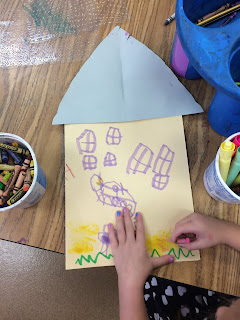To begin, we collected leaves that hadn't turned yet (read: are still green and not crunchy). Next, we used papier mache' paste to glue them to paper. Each student got one 9 x 12 piece of paper, and one 6 x 9 piece of paper. I stacked the entire class together and put a book on top so they'd dry flat. Confession--I didn't try it before hand, so I had no real idea if this would work or not, but it did, with only minimal sticking.
 |
| Papers after they'd been stacked. |
These were allowed to dry, and after they came off the drying rack, I put them under books again.
 |
| Fresh off the drying rack, pre book squishing. |
This worked well to keep everyone somewhat together, because they had something to work on as I was passing out papers for them to collage for their backgrounds. Their 9 x 12 painted paper was their base, and each student got a violet and green strip to add a hill with shadow, grass, rocks or similar items. They then cut the 6 x 9 paper, leaving a "halo" of paint around their leaves:
Finally, they cut their by-now-fully-colored animals and added them to their papers. Only one class is done so far, but so many of them are GREAT:
I think teachers should also hibernate, I know I could use a very long nap!




















































